How to Identify Pawpaws — Foraging for Edible Wild Fruits
- Authors
- Name
- Sam Sycamore
- @tanoaksam
- Published on
- Last updated
What are pawpaws?
The pawpaw (Asimina triloba) is a rare and exquisite treat that North Americans seem to have forgotten about somewhere along the way—though of course that's a pretty common story when it comes to native wild foods.
Pawpaws are understory trees that will form thick patches when conditions are ideal. They thrive where there's plenty of shade and the soil is fertile and well-drained.
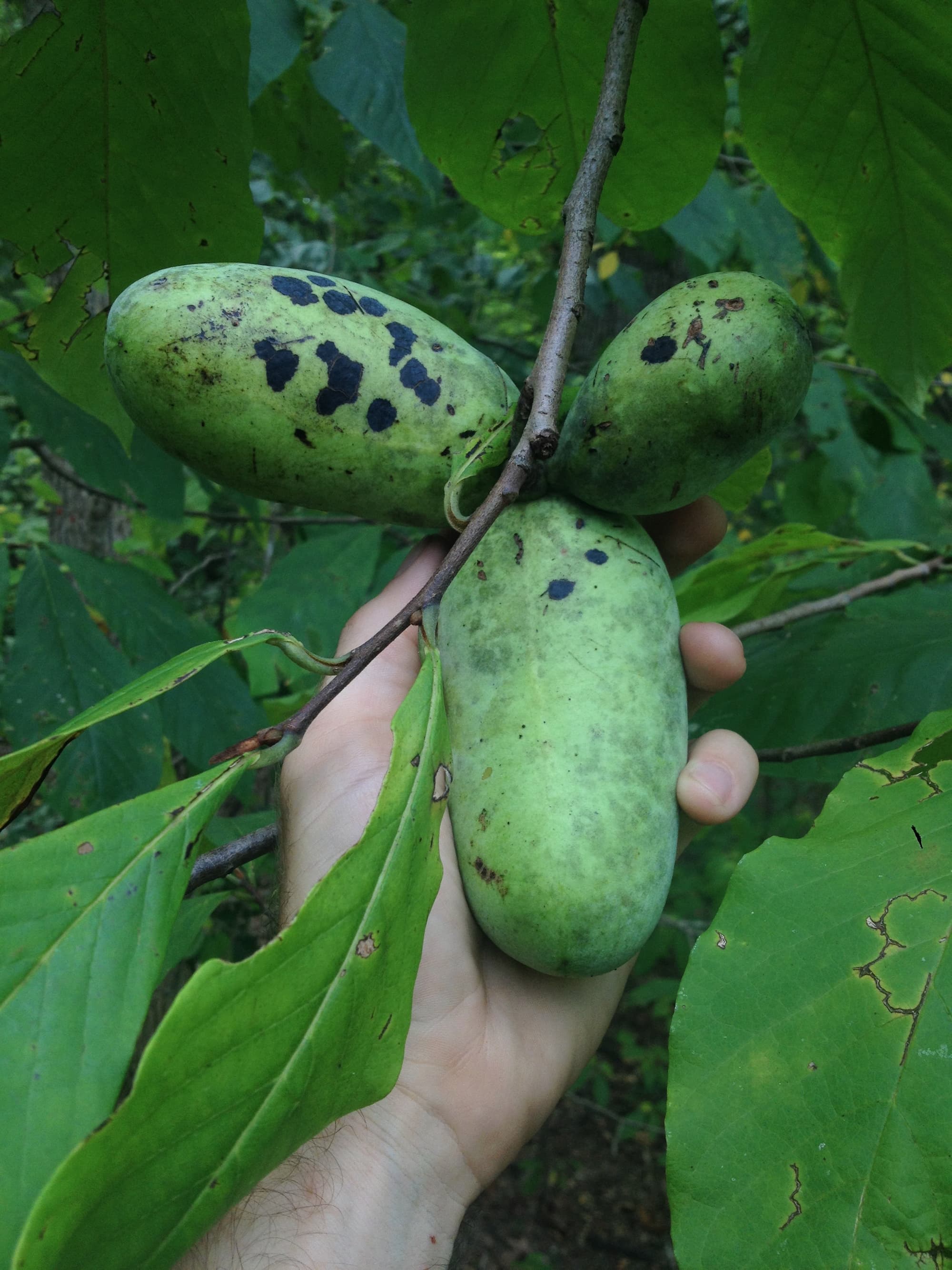
Pawpaw fruits can be difficult to spot while still in the tree—unless they happen to be hanging at eye level!
Are pawpaws edible?
Yes. The soft, mango-like fruits are edible when fully ripe.
The pawpaw fruit is considered to be the largest fruit native to North America (excluding gourds, which are technically fruits but typically classified as vegetables). They're not huge by any means—the size and shape, paired with the green-to-yellow, easily-bruised skin, may remind some of a small, misshapen pear at first glance.
But if you're lucky enough to stumble upon a ripe pawpaw, what you'll find when you slice it open is downright tropical: fragrant, tender flesh and a flavor that lands somewhere between mango, banana, and papaya.
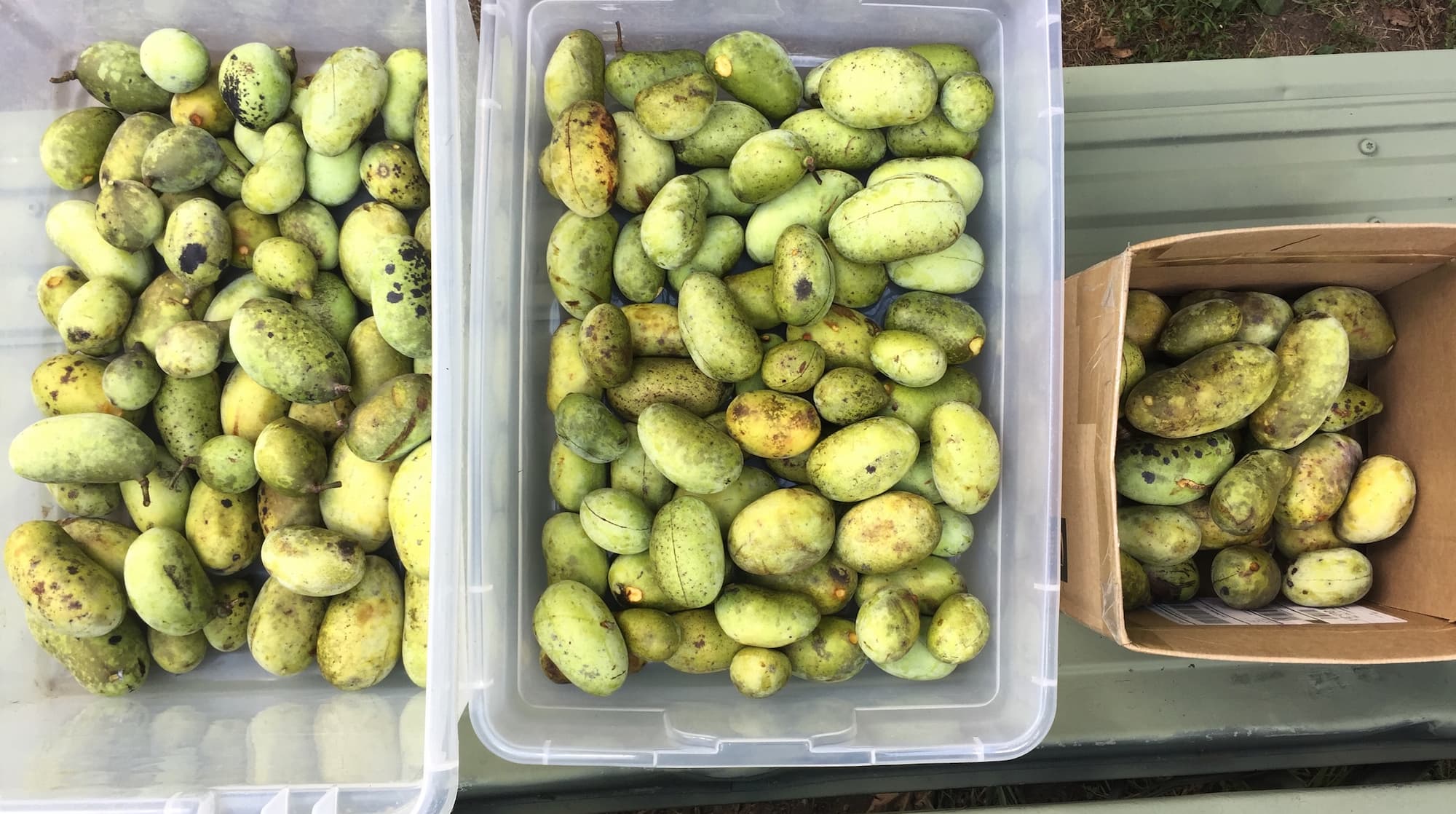
When you find a healthy pawpaw patch, you can gather hundreds of fruits in a matter of hours.
When to gather pawpaws
The earliest pawpaw fruits will begin to ripen at the tail-end of August in the warmer parts of their range in the Eastern US, which extends west to Nebraska, north to New York and Ontario, and south to northern Florida. Expect to find the majority of your ripe pawpaw fruits through the month of September, and possibly into early October in the northern end of its range.
Where to find pawpaws
Anthropological data suggests that indigenous peoples were intentional about cultivating the pawpaw well outside of its original native range in the Southeast, which is how it made its way up to southern Canada.
Pawpaws are finicky fruit producers because they need lots of shade to grow well in their first few years, but then require good sunlight in order to flower.
So the ideal pawpaw patch is one that is well established in the shade, but also happens to be growing near a forest edge or clearing where some of the clones get a decent amount of daily sun.
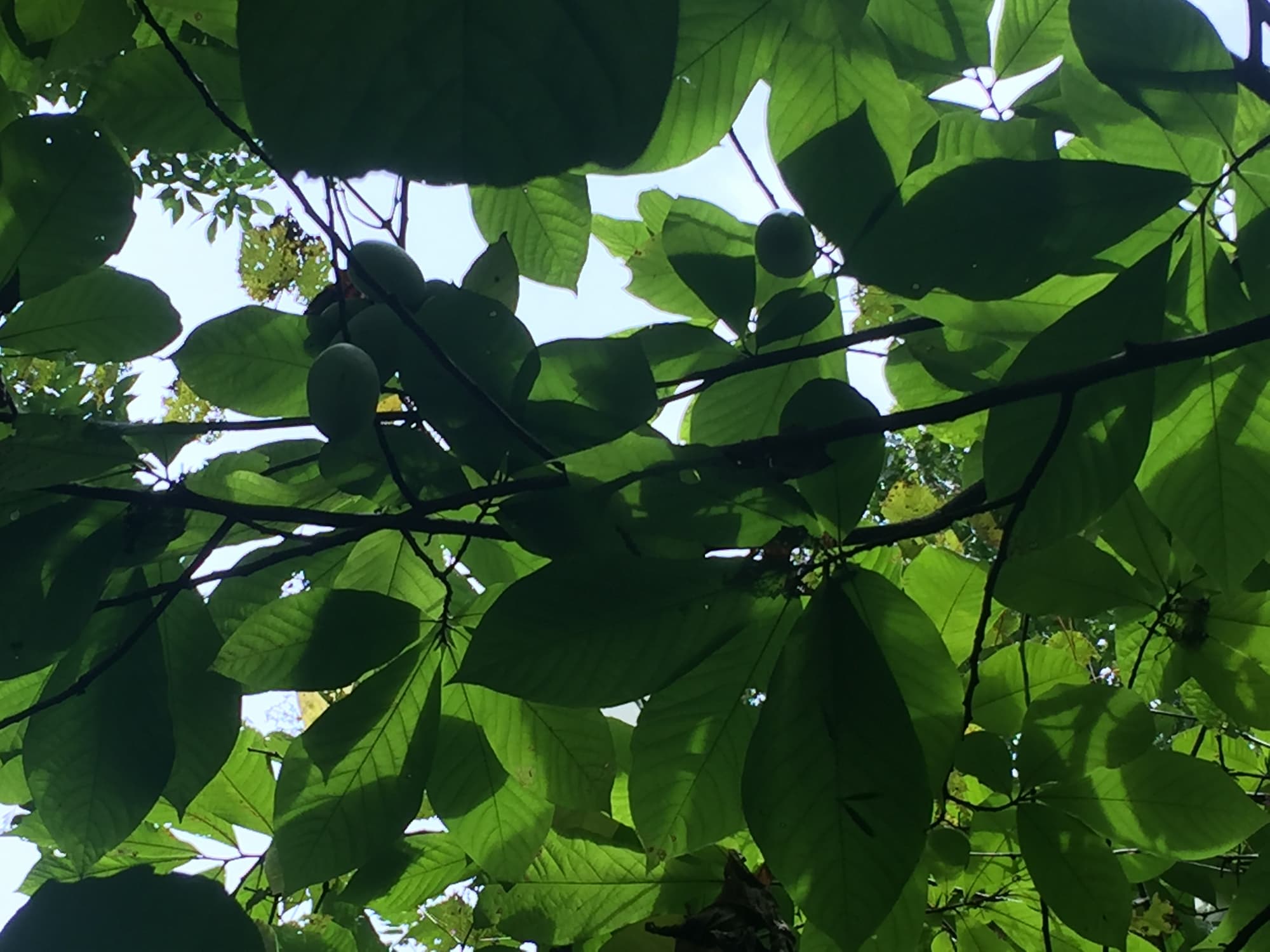
You can easily overlook a productive pawpaw tree because the fruits do not stand out among the leaves. Can you spot the fruits in this photo?
When you're way down yonder in the pawpaw patch, it's hard to tell if you're looking at one tree or fifty.
Sure, there may be fifty spindly grey stems adorned with fat, oblong leaves hanging anywhere from 3 to 15 feet above the ground.
But rather than relying on their seeds to spread, pawpaws instead propagate themselves by sending out clonal suckers from their roots, which look like new trees but are actually extensions of the "mother" tree. If you do find yourself in a pawpaw patch, look around for the biggest specimen you can find—chances are it will be centrally located, and it's likely responsible for most of the others surrounding it.
Not only does the sun access situation complicate matters, but then the issue of pollination throws another wrench in the system.
You see, pawpaws are pollinated by flies, carrion beetles and other related insects who spend their days searching for rotting flesh. The pawpaw flower attempts to court these bugs with an appropriately rank scent, but unfortunately for them it is very faint and doesn't always attract many takers, so it's rare to find more than a couple fruits on any given tree.
How to harvest and eat pawpaws
How do you know when pawpaws are ripe and ready to eat?
If you're really, really lucky you'll find a ripe, untouched fruit or two that have fallen to the ground, but chances are that the critters of the woods will beat you to those—not to mention many or all of the fruits you'd deem so-close-to-ripe-it's-not-funny.
If you see fruits up in the trees—they can be tricky to spot due to their inconspicuous appearance—give the trunk a good shaking. If the fruits fall, they're most likely ready to eat. They should be soft and a little squishy, with a yellowish hue to the green and brown-black skin. Don't be afraid of bruises! They should look a little beat-up when they're ready.
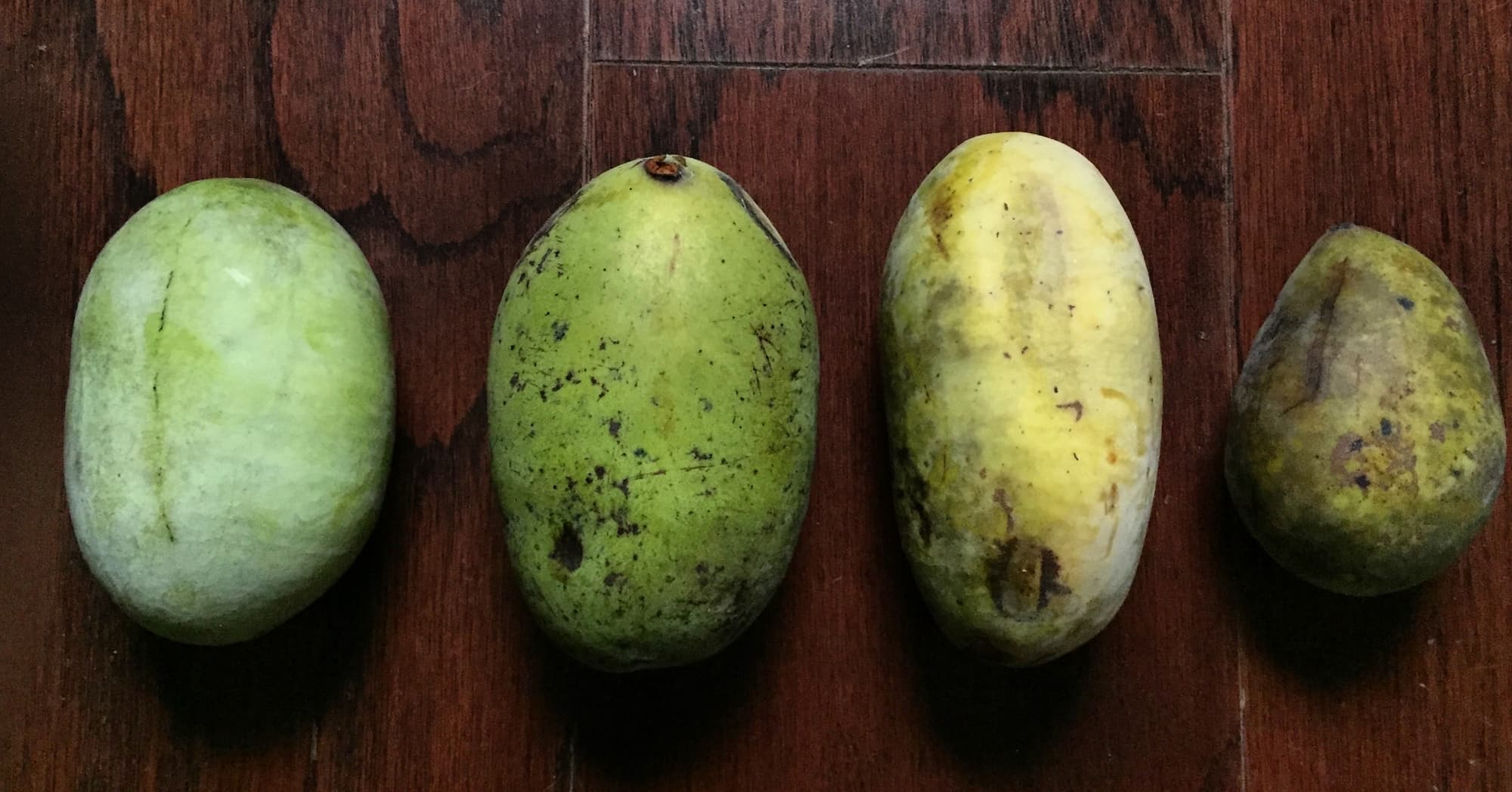
A comparison of four pawpaws from least to most ripe, left to right. The two on the right side are ready to eat.
If you find some fruits that aren't quite ripe yet but don't want to lose them to other creatures before you return, you can pick them and place them in a paper bag to finish ripening.
They won't ripen up quite as sweet this way, but if it's a choice between slightly-less-awesome fruit and no fruit at all, I think the decision is pretty easy to make. In my experience, this only works well if you're pretty sure the fruit would ripen on the tree within the next few days.
If pawpaws don't grow where you live—they have the smallest range out of all of the edible wild plants covered in Introduction to Foraging—then I hope you will consider this profile more as a case study that you can absorb and apply to your own local landscape.
If not pawpaws, what understory trees do you observe in your neck of the woods? What kinds of growth habits do they exhibit? What does that say about the local soil quality, topography, climate conditions, and the ecological relationships that those species have with their neighbors?
If you take the time to cultivate ecological literacy in this way, you'll have a better understanding of why nature operates the way that it does, and you'll be better equipped to work with the land rather than imposing your own desires upon it.
If I haven't made it obvious, this website is about a lot more than just plant identification and trendy foodie stuff. For me, eating with the seasons and foraging are gateways to a much deeper understanding of nature, and of our role in the web of life.
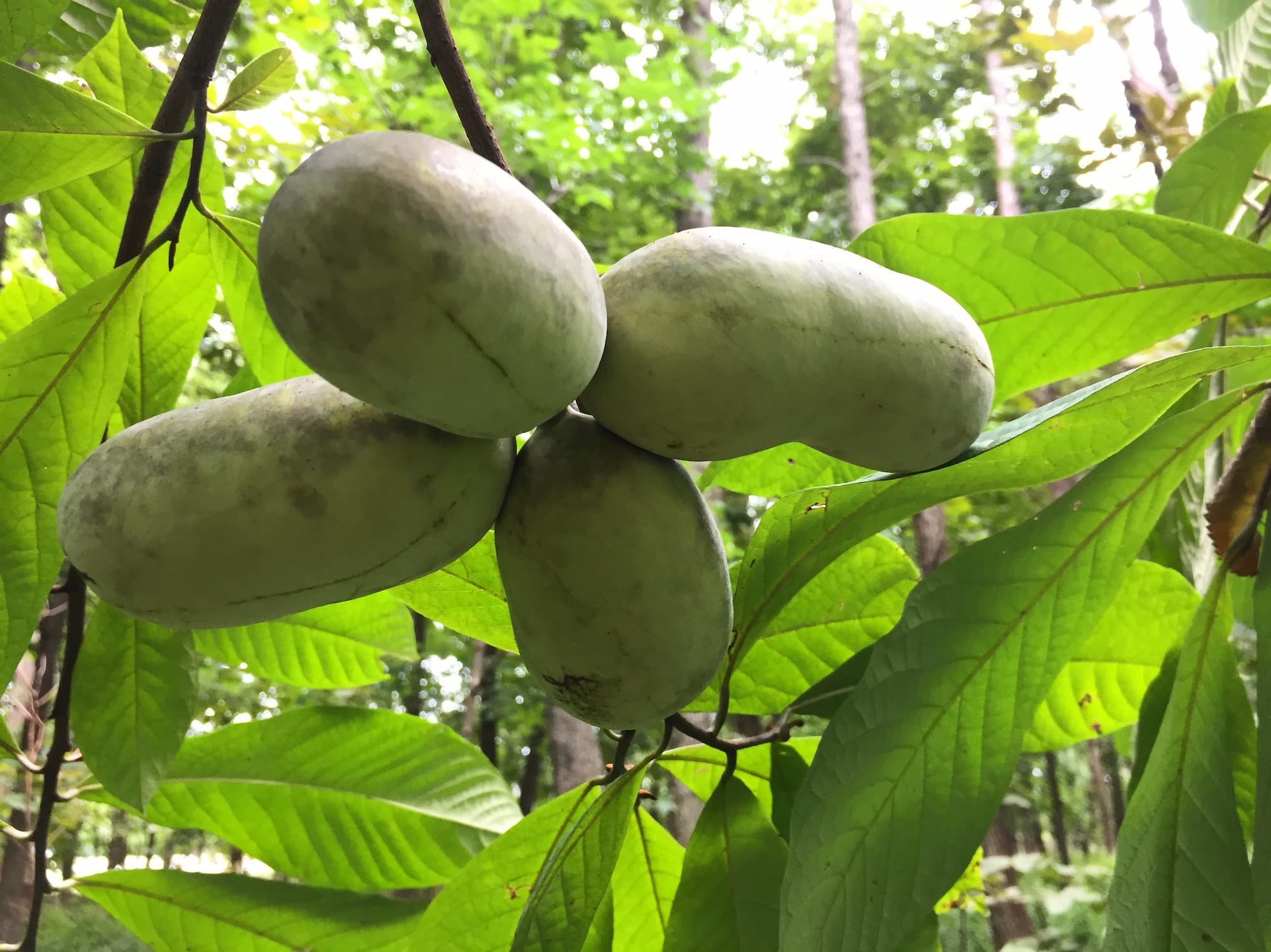
Foraging for wild fruits like pawpaws helps us to become a part of nature, rather than apart from it.
I want you to go out into the woods and hunt for pawpaws and other wild foods, absolutely, but in so doing I want you to be observing and interacting with your natural surroundings in ways that probably haven't been encouraged all that much in your life up to this point, unless you've been especially lucky.
When you really start to venture down this path in earnest, and get smacked in the head with the realization of how little you actually know, the effect is quite humbling. You may even begin to revere the natural world as you become aware of the limits of your own understanding of it.
Good. You could spend one hundred lifetimes in the woods and still feel like a novice. (Maybe you already have. See how far it's gotten you?) This is how it's supposed to be.
The more you learn about the Earth in all its complexity, the stranger and more mysterious it becomes. Now get out there and put some more mystery in your life!
Introduction to Foraging
Did you find this article helpful?
This is an excerpt from Introduction to Foraging: A Beginner's Guide to Gathering Wild Foods With Confidence.
Diving into the wonderful world of wild foods can be intimidating, especially if you don't have much experience working with plants.
Introduction to Foraging was written with the absolute beginner in mind, and with the goal of getting you out into the world gathering wild foods right away.
To learn everything you need to know to begin foraging safely, sustainably, and confidently, check out the book here. Happy hunting!